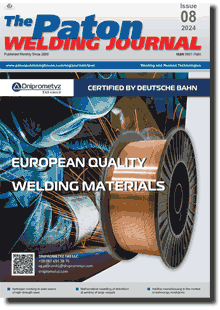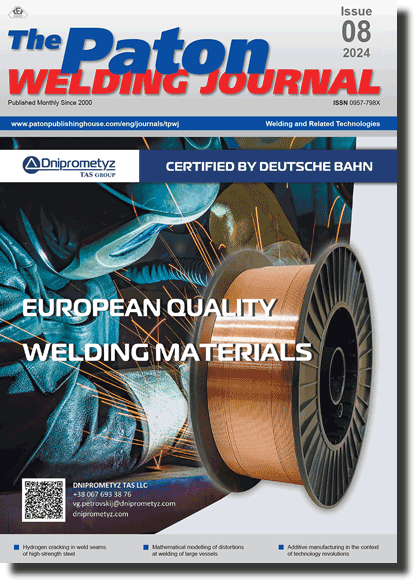| 2024 №08 (02) |
DOI of Article 10.37434/tpwj2024.08.03 |
2024 №08 (04) |

The Paton Welding Journal, 2024, #8, 18-25 pages
Mathematical modelling of distortions at welding of large vessels of aluminium alloy
B.R. Tsaryk, O.V. Makhnenko
E.O. Paton Electric Welding Institute of the NASU. 11 Kazymyr Malevych Str., 03150, Kyiv, Ukraine. E-mail: makhnenko@paton.kiev.uaAbstract
The problem of calculation prediction of the overall distortions of a large vessel made of aluminium alloy during friction stir welding (FSW) is considered. A mathematical model was developed using numerical methods of thermoplasticity analysis for determining the stress-strain state during FSW, by means of which it is possible to obtain residual plastic strains (the inherent strain function parameters) for both types of welded vessel joints (longitudinal and circumferential). This makes it possible to predict the overall distortions of a large cylindrical vessel with a great number of welded joints by the approximated method of inherent strains within the limits of the theory of elasticity. The reliability of the mathematical model for determination of the residual stresses and strains at FSW of aluminium alloy is confirmed by the agreement of the calculated distribution of the residual longitudinal stresses with the data of experimental measurements. This can contribute to ensuring the necessary accuracy of predicting the overall distortions of large vessels. The developed mathematical models and calculation algorithms can be effectively used for in-process prediction of the stress-strain state during assembly welding of large cylindrical vessels made of aluminium alloys.
Keywords:welded vessels, aluminium alloy, friction stir welding, plastic strains, residual stresses, mathematical modelling
Received: 01.07.2024
Received in revised form: 31.07.2024
Accepted: 30.08.2024
References
1. Poklyatskyi, A.G., Motrunich, S.I., Fedorchuk, V.Ye. et al. (2023) Mechanical properties and structural features of butt joints produced at FSW of aluminium alloys of different alloying systems. Avtomatych. Zvaryuvannya, 5, 18-26 [in Ukrainian]. https://doi.org/10.37434/as2023.05.022. Vasanthakumar Pandian, Sekar Kannan (2020) Numerical prediction and experimental investigation of aerospace-grade dissimilar aluminium alloy by friction stir welding. J. of Manufacturing Processes, 54, 99-108. https://doi.org/10.1016/j.jmapro.2020.03.001
3. Makhnenko, O.V., Muzhichenko, A.F. (2007) Mathematical modelling of thermal straightening of cylindrical shells and shafts with distortions along their longitudinal axis. The Paton Welding J., 9, 17-22.
4. Masabuchi, K. (1987) Analysis of welded structures residual stresses, distortions and their consequences. Pergamon Press, New-York.
5. Dresbach, C., van Enkhuizen, M.J., Alfaro Mercado, U. et al. (2015) Simulation of thermal behavior during friction stir welding process for predicting residual stresses. CAES Aeronautical J., 6, 271-278. https://doi.org/10.1007/s13272-014-0145-9
6. Tsaryk, B.R., Muzhychenko, O.F., Makhnenko, O.V. (2022) Mathematical model of determination of residual stresses and strains in friction stir welding of aluminium alloy. The Paton Welding J., 9, 33-40. https://doi.org/10.37434/tpwj2022.09.06
7. Makhnenko, O.V. (2010) Combined use of the method of thermoplasticity and the method of the shrinkage function for the study of the process of thermal straightening of shipbuilding panels. J. of Mathematical Sci., 167(2), 232-241. https://doi.org/10.1007/s10958-010-9917-x
8. Makhnenko, V.I. (1976) Calculation methods for studying the kinetics of welding stresses and deformations [in Russian]. Kyiv, Naukova Dumka.
9. Abdulrahaman Shuaibu Ahmad, Yunxin Wu, Hai Gong, Lin Nie (2019) Finite element prediction of residual stress and deformation induced by double-pass TIG welding of Al 2219 plate. Materials, 12(14), 2251. https://doi.org/10.3390/ma12142251
10. Timoshenko, S.P. (1976) Elasticity theory course [in Russian]. Kyiv, Naukova Dumka.
11. Saad B. Aziz, Mohammad W. Dewan, Daniel J. Huggett et. al. (2016) Impact of friction stir welding (FSW) process parameters on thermal modeling and heat generation of aluminum alloy joints. Acta Metallurgica Sinica, 29, 869-883. https://doi.org/10.1007/s40195-016-0466-2
Suggested Citation
B.R. Tsaryk, O.V. Makhnenko (2024) Mathematical modelling of distortions at welding of large vessels of aluminium alloy. The Paton Welding J., 08, 18-25.To order the electronic version of the paper:
B.R. Tsaryk, O.V. MakhnenkoMathematical modelling of distortions at welding of large vessels of aluminium alloy
The Paton Welding Journal №08 2024 p.18-25
The cost of article (pdf): 13 $, 12 €, 280 UAH (1 copy. )
fill in the form below:
The cost of subscription/purchase order journals or individual articles
| Journal/Currency | Annual Set | 1 issue printed |
1 issue |
one article |
| TPWJ/USD | 384 $ | 32 $ | 26 $ | 13 $ |
| TPWJ/EUR | 348 € | 29 € | 24 € | 12 € |
| TPWJ/UAH | 7200 UAH | 600 UAH | 600 UAH | 280 UAH |
| AS/UAH | 1800 UAH | 300 UAH | 300 UAH | 150 UAH |
| AS/USD | 192 $ | 32 $ | 26 $ | 13 $ |
| AS/EUR | 180 € | 30 € | 25 € | 12 € |
| SEM/UAH | 1200 UAH | 300 UAH | 300 UAH | 150 UAH |
| SEM/USD | 128 $ | 32 $ | 26 $ | 13 $ |
| SEM/EUR | 120 € | 30 € | 25 € | 12 € |
| TDNK/UAH | 1200 UAH | 300 UAH | 300 UAH | 150 UAH |
| TDNK/USD | 128 $ | 32 $ | 26 $ | 13 $ |
| TDNK/EUR | 120 € | 30 € | 25 € | 15 € |
AS = «Automatic Welding» - 6 issues per year;
TPWJ = «PATON WELDING JOURNAL» - 12 issues per year;
SEM = «Electrometallurgy Today» - 4 issues per year;
TDNK = «Technical Diagnostics and Non-Destructive Testing» - 4 issues per year.


